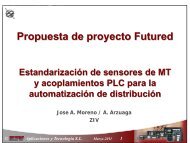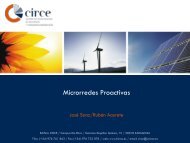Extensión del uso de los sincrofasores para facilitar la ... - Futured
Extensión del uso de los sincrofasores para facilitar la ... - Futured
Extensión del uso de los sincrofasores para facilitar la ... - Futured
You also want an ePaper? Increase the reach of your titles
YUMPU automatically turns print PDFs into web optimized ePapers that Google loves.
FUTURED<br />
24 Marzo 2011<br />
Extensión <strong><strong>de</strong>l</strong> <strong>uso</strong> <strong>de</strong> <strong>los</strong><br />
Sincrofasores <strong>para</strong><br />
<strong>facilitar</strong> <strong>la</strong> Integración <strong>de</strong><br />
<strong>la</strong>s EE.RR en el Sistema<br />
Eléctrico<br />
Jorge Car<strong>de</strong>nas, Senior Application Engineer<br />
David Menén<strong>de</strong>z, Smart Grid TSD Iberia<br />
GE Digital Energy
Sincrofasores…<br />
Definición<br />
El sincrofasor es un conjunto <strong>de</strong> valores<br />
analógicos y digitales con una<br />
referencia <strong>de</strong> tiempo universal, esta<br />
referencia es proporcionada por <strong>la</strong> red<br />
<strong>de</strong> satelites GPS.<br />
Al estar todas estas señales,<br />
in<strong>de</strong>pendientemente <strong>de</strong> su localización,<br />
alineadas en tiempo y procesadas como<br />
si estuvieran en una so<strong>la</strong> localización,<br />
permite realizar una supervisión y<br />
monitorización <strong>de</strong> <strong>la</strong> red en un<br />
verda<strong>de</strong>ro “tiempo real”.<br />
En <strong>la</strong>s re<strong>de</strong>s actuales <strong>la</strong> monitorización<br />
se realiza en un “pseudo tiempo real”,<br />
ya que <strong>los</strong> valores <strong>de</strong> <strong>la</strong>s medidas <strong>de</strong><br />
<strong>los</strong> parámetros <strong>de</strong> tensión e intensidad<br />
se envían cada 2 o 4 segundos, a<br />
diferencia <strong>de</strong> <strong>los</strong> <strong>sincrofasores</strong> que<br />
pue<strong>de</strong>n enviarse <strong>de</strong> 25 a 100 veces por<br />
segundo<br />
GE Proprietary &<br />
2<br />
3/28/2011
Sincrofasores…<br />
Normativa y Hardware<br />
Estándar IEEE C37-118<br />
IEEE Standard for<br />
Synchrophasors for Power<br />
Systems, (22/03/2006)<br />
PMU: Phasor Measurement Unit<br />
Equipo medidor <strong>de</strong><br />
<strong>sincrofasores</strong>.<br />
Mi<strong>de</strong>, registra, reporta<br />
<strong>sincrofasores</strong>.<br />
PDC: Phasor Data Concentrator<br />
Equipo concentrador <strong>de</strong> datos<br />
<strong>de</strong> <strong>sincrofasores</strong>.<br />
Recibe, registra, procesa y<br />
realiza <strong>la</strong>s aplicaciones<br />
avanzadas con <strong>los</strong><br />
<strong>sincrofasores</strong><br />
GE Proprietary &<br />
3<br />
3/28/2011
Sincrofasores…<br />
Teoría<br />
Señal<br />
Señal <strong>de</strong><br />
Tiempo<br />
UTC<br />
Ventana <strong>de</strong> datos<br />
Filtro coseno<br />
Extrae <strong>la</strong> parte real, X re<br />
Filtro seno<br />
Extrae <strong>la</strong> parte imaginaria, X im<br />
GE Proprietary &<br />
4<br />
3/28/2011
Sincrofasores…<br />
Cálculo <strong><strong>de</strong>l</strong> <strong>de</strong>sfase <strong>de</strong> <strong>la</strong> onda<br />
x(t)<br />
IRIG-B 1 PPS<br />
Se <strong>de</strong>fine <strong>la</strong> fase <strong>de</strong> <strong>la</strong> señal como 0 si el f<strong>la</strong>nco ascen<strong>de</strong>nte <strong>de</strong> <strong>la</strong> señal UTC<br />
coinci<strong>de</strong> con el máximo <strong>de</strong> dicha señal.<br />
GE Proprietary &<br />
5<br />
3/28/2011
Aplicaciones generales<br />
con <strong>sincrofasores</strong>
Sincrofasores…<br />
Algunas aplicaciones generales con <strong>sincrofasores</strong><br />
Gestión <strong>de</strong> <strong>la</strong> Red<br />
• Estimador <strong>de</strong> estado lineal<br />
• Visualización <strong><strong>de</strong>l</strong> Sistema Electrico en “tiempo real”<br />
• Oscilografía<br />
coordinada <strong>para</strong><br />
un mejor análisis<br />
post-morten<br />
• Análisis <strong>de</strong><br />
Estabilidad<br />
Transitoria<br />
• Detección <strong>de</strong><br />
Osci<strong>la</strong>ciones<br />
Inter-área<br />
• Cálculo preciso <strong>de</strong> <strong>los</strong> parámetros<br />
<strong>de</strong> <strong>la</strong> Red Eléctrica<br />
GE Proprietary &<br />
• Protecciones <strong>de</strong><br />
respaldo<br />
• Detección <strong>de</strong> pérdida<br />
<strong>de</strong> paso adaptativa<br />
• Detección más precisa<br />
<strong><strong>de</strong>l</strong> punto <strong>de</strong> falta<br />
7<br />
3/28/2011
Sincrofasores…<br />
Ejemp<strong>los</strong> <strong>de</strong> aplicación en Energías Renovables<br />
El <strong>uso</strong> <strong>de</strong> <strong>los</strong> Sincrofasores pue<strong>de</strong> ayudar en <strong>la</strong> integración <strong>de</strong> <strong>la</strong>s energías<br />
renovables al permitir mantener niveles simi<strong>la</strong>res <strong>de</strong> fiabilidad en <strong>la</strong> red a<br />
medida que <strong>la</strong> potencia transmitida por <strong>la</strong> Red Eléctrica aumenta.<br />
La regu<strong>la</strong>ción <strong>de</strong> <strong>la</strong> tensión en <strong>la</strong> Red Eléctrica no es compatible con <strong>la</strong><br />
variabilidad inherente <strong>de</strong> <strong>la</strong>s energías renovables, por ejemplo, el viento no es<br />
constante, así como <strong>la</strong> luz <strong><strong>de</strong>l</strong> sol.<br />
El <strong>uso</strong> <strong>de</strong> <strong>los</strong> <strong>sincrofasores</strong> pue<strong>de</strong> permitir corregir el efecto <strong>de</strong> estas<br />
variaciones en <strong>la</strong> Red <strong>de</strong> forma casi instantánea con <strong>la</strong> actuación sobre <strong>los</strong><br />
distintos equipos que regu<strong>la</strong>n <strong>los</strong> flujos <strong>de</strong> Potencia Activa y Reactiva en <strong>la</strong><br />
Red como por ejemplo: SVCs o STATCOMs<br />
A medida que <strong>los</strong> equipos con <strong>sincrofasores</strong> se incrementen en <strong>la</strong>s Re<strong>de</strong>s<br />
Eléctricas, se dispondrá <strong>de</strong> mas información que convenientemente<br />
corre<strong>la</strong>cionada y tratada con <strong>la</strong>s aplicaciones que se <strong>de</strong>see, permitirá<br />
aumentar <strong>los</strong> intercambios <strong>de</strong> energía en <strong>la</strong> Red con <strong>la</strong> infraestructura actual<br />
sin afectar a <strong>la</strong> fiabilidad.<br />
GE Proprietary &<br />
8<br />
3/28/2011
Aplicaciones en Energía Eólica
Sincrofasores…<br />
Perfil <strong>de</strong> Tensiones <strong>de</strong> <strong>la</strong> Red Españo<strong>la</strong> en distintas<br />
situaciones <strong>de</strong> operación <strong>de</strong> <strong>los</strong> aerogeneradores<br />
Fuente: “Estudio <strong><strong>de</strong>l</strong> sistema Ibérico ante un aumento <strong>de</strong> generación eólica”<br />
Autor :Luca <strong>de</strong> Tena Costales, Diego.<br />
Institute of Process Engineering and Power P<strong>la</strong>nt Technology (IVD). Universität Stuttgart<br />
GE Proprietary &<br />
10<br />
3/28/2011
Sincrofasores…<br />
Mejora <strong>de</strong> <strong>la</strong> Estabilidad en <strong>la</strong> integración <strong>de</strong> Energía Eólica<br />
en <strong>la</strong> Red Eléctrica<br />
GE Proprietary &<br />
11<br />
3/28/2011
Sincrofasores…<br />
Respuesta transitoria ante una perturbación en <strong>la</strong> red<br />
Tensión en <strong>la</strong> Barra 6 en<br />
condición <strong>de</strong> apertura <strong>de</strong> <strong>la</strong> línea<br />
entre <strong>la</strong>s barras 1 y 2 durante 200<br />
ms y posteriormente una falta<br />
trifásica <strong>de</strong> 200 ms duración en <strong>la</strong><br />
Barra 7.<br />
Fuente: “Intelligent Integration of a Wind Farm to an Utility Power Network with Improved Voltage Stability”,<br />
Autores: Vamsi K. Polisetty, Stu<strong>de</strong>nt Member, IEEE, Sandhya R. Jetti, Stu<strong>de</strong>nt Member, IEEE, Ganesh K. Venayagamoorthy, Senior<br />
Member, IEEE and *Ronald G. Harley, Fellow, IEEE<br />
GE Proprietary &<br />
12<br />
3/28/2011
Aplicaciones en Energía So<strong>la</strong>r<br />
Fotovoltáica
Sincrofasores…<br />
Descripción <strong><strong>de</strong>l</strong> problema<br />
Generales <strong>para</strong> DG<br />
Flujo bi-direccional<br />
Cambio constante en el nivel <strong>de</strong><br />
fat<strong>la</strong> asociado con conex./<strong>de</strong>sc. DG<br />
en el sistema<br />
Control Volt/Var afecta pot. corto<br />
Insuficiente sensibilidad <strong>de</strong> <strong>la</strong>s<br />
protecciones tradicionales<br />
Excesivos picos <strong>de</strong> tensión durante<br />
el paso a is<strong>la</strong> transmitidas a MT<br />
Calidad <strong>de</strong> onda<br />
Reenganche fuera <strong>de</strong> sincronismo<br />
Funcionamiento en is<strong>la</strong> durante<br />
maniobras en <strong>la</strong> red MT<br />
Condiciones peligrosas <strong>de</strong> trabajo<br />
<strong>para</strong> el personal <strong>de</strong> mantenimiento<br />
y operación <strong>de</strong> <strong>la</strong> red<br />
Fal<strong>los</strong> <strong>de</strong> automatismos <strong>de</strong> <strong>la</strong> red<br />
por variación <strong>de</strong> parámetros<br />
eléctricos en el rango normal <strong>de</strong><br />
operación<br />
NDZ (None-<strong>de</strong>tection-zone)<br />
GE Proprietary &<br />
14<br />
3/28/2011
Sincrofasores…<br />
Evaluación <strong>de</strong> <strong>los</strong> métodos <strong>de</strong> <strong>de</strong>tección anti-is<strong>la</strong> en PV<br />
Method Type Strenghts Weaknesses<br />
Un<strong>de</strong>r/over voltage and un<strong>de</strong>r/over<br />
frequency<br />
P / I Low-cost and used for general protection Large NDZ and varible/unpredictible reaction time<br />
Voltage phase jump <strong>de</strong>tection P / I Easy implementation, not affect output PQ, not impact<br />
system transient response<br />
Detection of Harmonics P / I Highly successful in <strong>de</strong>tecting is<strong>la</strong>nding un<strong>de</strong>r a wi<strong>de</strong><br />
range of conditions<br />
Impedance measurment A/ I Theoretically extremely small NDZ for a single PV<br />
inverter<br />
Difficult to set thresholds for reliable is<strong>la</strong>nding <strong>de</strong>tection<br />
Serious implementation difficulty, trip threshold<br />
Output variation has many weaknesses<br />
Detection of impedance at specific<br />
frecuency (special Harm. <strong>de</strong>tection)<br />
A/ I Highly successful in <strong>de</strong>tecting is<strong>la</strong>nding un<strong>de</strong>r a wi<strong>de</strong><br />
range of conditions<br />
Serious implementation difficulty, trip threshold<br />
Slip Mo<strong>de</strong> Frequency Shift A/ I Easy implementation, small NDZ Deacrease in the output PQ<br />
Frequency bias A/ I In micro-controller-based inverters, this method is<br />
re<strong>la</strong>tively easy to implement<br />
Deacrease in the output PQ<br />
Mains Monitoring Units with Allocated<br />
All-pole Switching Devices<br />
Connected in Series (MSD)<br />
A/I<br />
Redundant <strong>de</strong>sign and regu<strong>la</strong>r self tests on inverter<br />
startup allow user to install the unit without the need for<br />
periodic checks to <strong>de</strong>termine if the anti-is<strong>la</strong>nding<br />
circuitry is functional<br />
Injections will interfere with another or interaction of multiple<br />
units cause false trips<br />
Impedance insertion Utility Highly effective, capacitors<br />
of this type are readily avai<strong>la</strong>ble<br />
Expense of the capacitor bank, multiple switches in series<br />
leading into the potential is<strong>la</strong>nd, and possibly multiple branches<br />
capable of energizing the potential is<strong>la</strong>nd speed of response,<br />
instal<strong>la</strong>tion of equipment on the utility si<strong>de</strong><br />
Use of PLC communications Utility +<br />
Inverter<br />
Increased connection <strong>de</strong>nsity of distributed generation<br />
PLCC transmitter on the utility system capable of sending<br />
signals through the distribution system to all inverters<br />
Signal produced by disconnect Utility +<br />
Inverter<br />
This method would allow additional control of the<br />
distributed generators by the utility, resulting in<br />
coordination between distributed generators and utility<br />
resources<br />
It would be necessary to instrument all series or <strong>para</strong>llel<br />
switches leading to a potential is<strong>la</strong>nd. Additional wiring for<br />
communications, this could be avoi<strong>de</strong>d using a microwave link.<br />
Fuente: “Evaluation of Is<strong>la</strong>nding Detection Methods for Utility-Interactive Inverters in Photovoltaic Systems”<br />
Ward Bower y Michael Ropp.<br />
Sandia National Laboratories<br />
GE Proprietary &<br />
15<br />
3/28/2011
Sincrofasores…<br />
Detección operación en is<strong>la</strong> en p<strong>la</strong>ntas fotovoltáicas<br />
<br />
Método <strong>de</strong> <strong>de</strong>tección basado en<br />
<strong>sincrofasores</strong>:<br />
Método diferencia <strong>de</strong> ángu<strong>los</strong>:<br />
En este método el relé com<strong>para</strong> <strong>la</strong> diferencia<br />
<strong>de</strong> ángu<strong>los</strong> con el valor <strong>de</strong> ajuste.<br />
+<br />
Método <strong>de</strong> <strong>la</strong> aceleración-<strong>de</strong>slizamiento:<br />
Este método monitoriza <strong>la</strong> tasa <strong>de</strong> cambio <strong>de</strong><br />
fase (<strong>de</strong>slizamiento). A su vez <strong>la</strong> tasa <strong>de</strong><br />
cambio <strong><strong>de</strong>l</strong> <strong>de</strong>slizamiento es <strong>la</strong> aceleración<br />
entre dos puntos en un sistema eléctrico.<br />
+<br />
Información proveniente <strong>de</strong> <strong>los</strong><br />
inversores<br />
Parámetros monitorizados: LMO (3 ph <strong>los</strong>sof-<br />
mains-<strong>de</strong>tection, ROCOF (rate-of-changeof-frequency)<br />
y LVRT (low-voltage-ri<strong>de</strong>through)<br />
=<br />
DETECCIÓN<br />
GE Proprietary &<br />
16<br />
3/28/2011
Interoperabilidad
Sincrofasores…<br />
Interoperabilidad<br />
Ensayos multifabricante en el Simu<strong>la</strong>dor Analógico <strong><strong>de</strong>l</strong> Instituto <strong>de</strong><br />
Investigación <strong>de</strong> Transmisión R<strong>uso</strong>, NIIPT, Septiembre 2006<br />
GE Proprietary &<br />
18<br />
3/28/2011
Sincrofasores<br />
Interoperabilidad: Medidas<br />
Ensayos multifabricante en el Simu<strong>la</strong>dor Analógico <strong><strong>de</strong>l</strong> Instituto <strong>de</strong><br />
Investigación <strong>de</strong> Transmisión R<strong>uso</strong>, NIIPT, Septiembre 2006<br />
Ángulo Va medido por PMU1 en nodo 1<br />
menos ángulo medido por PMU3 en nodo 3<br />
Potencia <strong>de</strong> <strong>la</strong> línea 1-3 medida por PMU3 en<br />
nodo 3<br />
Cortocircuito monofásico en <strong>la</strong> línea 1-5 cerca <strong>de</strong> <strong>la</strong> Barra SDPP con<br />
reenganche monofásico <strong>de</strong>spués <strong>de</strong> 5 segundos<br />
GE Proprietary &<br />
19<br />
3/28/2011
Arquitectura
Sincrofasores…<br />
Arquitectura <strong>de</strong> un concentrador <strong>de</strong> <strong>sincrofasores</strong><br />
GE Proprietary &<br />
21<br />
3/28/2011
Sincrofasores…<br />
Ejemplo <strong>de</strong> arquitectura <strong>de</strong> una red <strong>de</strong> <strong>sincrofasores</strong><br />
Interfaz <strong>de</strong><br />
Usuario y<br />
Aplicaciones<br />
Super Archivo<br />
/Histórico<br />
• Históricos<br />
• Frecuencias <strong>de</strong> <strong>la</strong> Red<br />
• Eventos<br />
• etc<br />
STM1/4<br />
SONET<br />
Wireless<br />
(opción)<br />
EMS<br />
Subestación 1<br />
PDC – con<br />
Histórico<br />
GE Proprietary &<br />
Subestación<br />
22<br />
3/28/2011
Sincrofasores…<br />
Opciones <strong>de</strong> jerarquía <strong>de</strong> <strong>los</strong> concentradores (PDC) <strong>de</strong><br />
<strong>sincrofasores</strong><br />
DESPACHO CENTRAL<br />
Desiciones <strong>de</strong> alta velocidad<br />
Rango <strong>de</strong>100 ms – 1S<br />
Adquisicion y<br />
Decisión<br />
Adquisicion y<br />
Decisión<br />
Decisiones <strong>de</strong><br />
muy alta<br />
velocidad<br />
Rango <strong>de</strong> 10-100<br />
ms<br />
Adquisicion y<br />
Decisión<br />
Adquisicion y<br />
Decisión<br />
PMU PMU PMU PMU PMU PMU PMU PMU PMU<br />
GE Proprietary &<br />
23<br />
3/28/2011
Conclusiones
Sincrofasores…<br />
Conclusiones<br />
Las aplicaciones actuales están basadas en magnitu<strong>de</strong>s<br />
esca<strong>la</strong>res<br />
Los <strong>sincrofasores</strong> suponen un salto cuántico en el<br />
<strong>de</strong>sarrollo <strong>de</strong> Sistemas <strong>de</strong> Monitorización, Control y<br />
Protección <strong>de</strong> Red mas eficaces.<br />
El Estándar está <strong>de</strong>finido (IEEE C37.118)<br />
La tecnología existe (PMU+PDC)<br />
La interoperabilidad entre fabricantes está probada<br />
Jorge Car<strong>de</strong>nas (jorge.car<strong>de</strong>nas@ge.com)<br />
David Menén<strong>de</strong>z (david.menen<strong>de</strong>z@ge.com)<br />
GE Proprietary &<br />
25<br />
3/28/2011
GE Proprietary &






